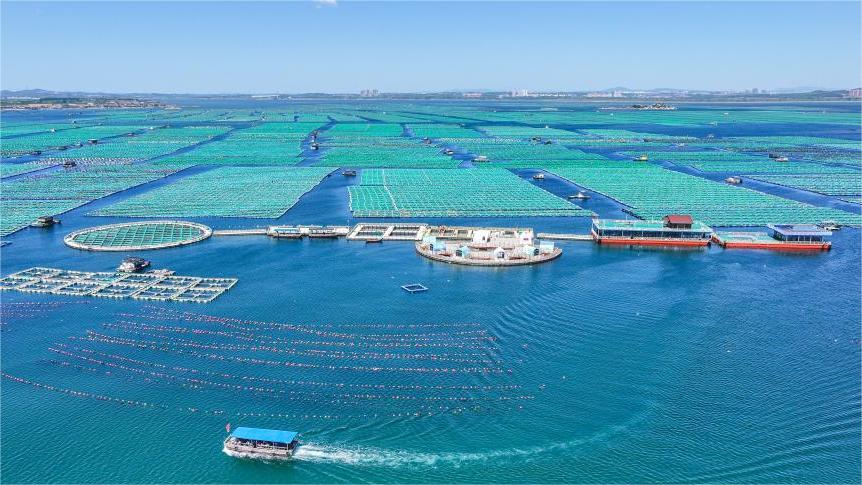Booming seafood industry mirrors China's "blue granary" development
FUZHOU, May 16 (Xinhua) -- In a coastal county in east China's Fujian Province, fishermen are fully immersed in harvesting kelp, while trucks loaded with fresh seaweed bustle back and forth.
"This year's kelp harvest season started after the Spring Festival and is nearing its end," said Lin Zhexian, a 61-year-old fisherman in Lianjiang County, adding that he set off around midnight, collecting nearly 5.4 tonnes of fresh kelp in a single day.
Spanning a sea area of 3,112 square km, Lianjiang saw its output of aquatic products, including seaweed and abalone, reach nearly 1.29 million tonnes in 2023, with a total output value of around 30.69 billion yuan (about 4.32 billion U.S. dollars).
The booming seafood industry exemplifies Fujian's efforts to promote its marine economy. Situated by the East China Sea, the province boasts a sea area of 136,000 square km, a rugged coastline and numerous bays and islands, making it an optimal place for developing mariculture.
In China's "No. 1 central document" for 2023, the Chinese government called for accelerating the development of deep-sea and far-sea mariculture as it makes efforts to safeguard the country's food security by stocking its "blue granary."
In 2023, Fujian's mariculture output was nearly 5.8 million tonnes, ranking second in the country. In the Chinese market, more than 80 percent of farmed large yellow croaker, over 70 percent of abalone and about 50 percent of kelp come from Fujian.
Fujian, however, is not the only significant contributor. South China's Guangdong Province, a major producer of aquatic products, saw its total output of aquatic products reach nearly 9.24 million tonnes last year, accounting for one-seventh of the country's total.
Regarding the health of its citizens as a significant indicator of the country's prosperity, China has adopted an all-encompassing approach to agriculture and food. It is committed to building a diversified food supply system while developing foods with higher nutrient content for different demographic groups and their diverse health needs.
A rich source of protein, dietary fiber and minerals, seafood has not only been the main course for people in coastal areas like Fujian but has also served as a sought-after delicacy for foodies, enriching the dinner table of Chinese people.
Seafood is in great demand, according to Lin Zhelong, chairman of a marine product development company in Lianliang. "Take kelp as an example. It takes only a week from procuring kelp to delivering the processed kelp products," he explained.
The company has developed 16 types of kelp products, including instant soup and dried kelp strips, and supplied the products to supermarkets across the country.
Today, seafood isn't just served as various delicacies; it has also been transformed into snack foods to meet the demands of younger consumers.
According to Qiu Bixiang, general manager of Fujian Yida Foods Co. Ltd., which specializes in ultra-processed seafood, the company has developed over 30 kinds of seafood snacks, such as kelp crisps, kelp cakes and jellyfish strips.
"The ready-to-eat snacks are popular among consumers. The production schedule of our facilities spans until 2025, with all five production lines operating at peak efficiency to expedite the process," Qiu said.
According to Qiu, the company plans to add three new production lines to meet the surging orders and venture into creating seafood drinks and cosmetics to cater to consumers' evolving tastes.
Photos
Related Stories
- Fujian builds diverse food supply system with all-encompassing approach to food
- Fujian's innovations lead nation's quest for food security
- Chinese mainland to resume tourism for Fujian residents to visit Matsu
- Tea industry in Fujian prospers through diversified development
- China among largest importers of Vietnam's fishery products in Q1
Copyright © 2024 People's Daily Online. All Rights Reserved.









